Each year, I construct a Misery Index. The idea of such an index to measure economic misery was introduced by economist Art Okun in the 1960s as a way to provide President Lyndon Johnson with an easily digestible snapshot of the economy. That original Misery Index was just a simple sum of a nation’s annual inflation rate and its unemployment rate. The Index has been modified several times, first by Robert Barro of Harvard and then by me.
My modified Misery Index is the sum of the unemployment, inflation and bank lending rates, minus the percentage change in real GDP per capita. Higher readings on the first three elements are “bad” and make people more miserable. These are offset by a “good” (GDP per capita growth), which is subtracted from the sum of the “bads.” A higher Misery Index score reflects a higher level of “misery,” and it’s a simple enough metric that a busy president, without time for extensive economic briefings, can understand it at a glance.
Hanke’s Annual Misery Index 2018 covered 95 countries that report relevant data on a timely basis. For consistency and comparability, and with few exceptions, data were retrieved from the Economist Intelligence Unit.
Thailand took the prize as the least miserable country in the world on the 2018 Misery Index, with a rock-bottom score of 1.7. It’s 2018 rank of No. 95 out of 95 countries is a stunner. The military junta delivered happiness, and as a result, the pro-military PPRP was rewarded at the polls. Indeed, the PPRP raked in the largest popular vote, even though the vote count was embroiled in controversy.
Hungary delivered yet another stunner, making a dramatic improvement from 2017 to 2018. It came in at No. 94, as the second least miserable country in the world with a score of only 2.6. While the European Union and the international elites have thrown everything they can throw at Prime Minister Viktor Orbán, it’s easy to see why he commands a strong following at home. After all, the Magyars were the 2nd happiest in the world in 2018.
When we dive down into the depths of misery (read: high scores on the Misery Index), we hit Venezuela, 2018’s most miserable country. Its score was an amazing 1,746,439.1. Hyperinflating Venezuela was followed by Argentina, another Latin America country that is crisis-prone. To list but a few of Argentina’s currency crises: 1876, 1890, 1914, 1930, 1952, 1958, 1967, 1975, 1985, 1989, 2001, and 2018. You would think the Argentines would wise up and dump the peso, replacing it with the greenback. But, this has yet to happen.
That brings me to the third most miserable country, Iran. It also brings me to the countries in the country group—the Middle East and North Africa (MENA)—that Iran belongs to.
If we examine the MENA group, two things stand out. First, there is a lot of misery in MENA. Iran, Turkey, Egypt, Jordan, and Saudi Arabia have poor scores, as shown in the table below. To put these country scores into perspective, just consider that, when compared to the 95 countries covered; Iran is the 3rd most miserable country; Turkey is 5th; Egypt is 9th; Jordan is 12th; Saudi Arabia is 18th; and Algeria is the 22nd most miserable.

The second striking feature of the MENA group is that I am only able to reliably compute misery index scores for nine countries due to data shortcomings. But, the MENA group contains 22 countries. So, 13 countries are missing in action, or as they say in the military, absent without leave (AWOL).
The AWOL countries are flying blind. Their bloated bureaucracies can’t even produce timely and reliable basic economic metrics. Without good data on the economic dashboard, danger lurks. Indeed, without reliable data, everyone is in the dark. Perhaps that’s what the AWOL governments desire? More likely is a simple fact that incompetence and corruption make it impossible to produce basic economic data.
If we move from MENA to Sub-Saharan, we literally enter a data black hole, for the most part. As shown below, only four countries out of the 48 in this geographic group reliably report data. Forty-four countries are AWOL. And, of the four that report data, Nigeria, as the world’s sixth most miserable, and South Africa, as the world’s seventh most miserable, are, well, pretty close to the bottom of the barrel.

Africa is flying blind. And, as far as we can detect, many of the countries are pretty miserable.
Steve Hanke is a professor of applied economics at The Johns Hopkins University and senior fellow at the Cato Institute. He is a columnist at Forbes and a regular contributor to The Wall Street Journal. Over four decades Hanke has advised dozens of world leaders from Ronald Reagan to Indonesia’s Suharto on currency reforms, infrastructure development, privatization, and how to tame hyperinflation. You can follow him on twitter @steve_hanke.
First appeared in Forbes.

